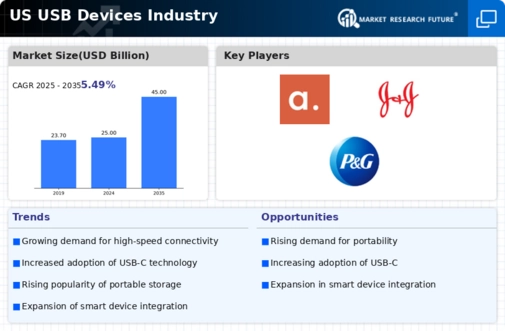Increased Focus on Data Security
In an era where data breaches are prevalent, the usb devices market is experiencing a heightened focus on data security. Consumers and businesses alike are becoming more aware of the risks associated with data transfer and storage. As a result, there is a growing demand for usb devices that incorporate advanced security features, such as encryption and biometric authentication. The usb devices market must respond to this trend by developing products that not only meet performance standards but also prioritize user security. This shift is likely to influence purchasing decisions, as consumers seek reliable solutions to protect their sensitive information.
Rising Adoption of Smart Devices
The increasing prevalence of smart devices in the US is a pivotal driver for the usb devices market. As consumers integrate smart home technologies, wearables, and IoT devices into their daily lives, the demand for compatible usb devices surges. In 2025, it is estimated that over 70% of households will own at least one smart device, necessitating a robust supply of usb connectors and hubs. This trend indicates a shift towards multifunctional usb devices that can support various applications, enhancing user experience. The usb devices market must adapt to this growing ecosystem by offering innovative solutions that cater to the diverse needs of consumers, thereby driving market growth.
Expansion of E-Commerce Platforms
The rapid expansion of e-commerce platforms in the US has significantly influenced the usb devices market. With online sales projected to reach $1 trillion by 2025, the demand for usb devices, particularly for shipping and logistics, is expected to rise. Retailers increasingly rely on usb technology for inventory management, data transfer, and customer engagement. This trend suggests that the usb devices market must focus on providing reliable and efficient products that meet the needs of e-commerce businesses. Furthermore, the convenience of online shopping has led to a broader consumer base, increasing the overall demand for usb devices across various sectors.
Growth of Remote Work and Learning
The growth of remote work and learning in the US has created new opportunities for the usb devices market. As more individuals and organizations adopt flexible work arrangements, the need for reliable connectivity solutions has intensified. USB devices, such as hubs and adapters, play a crucial role in facilitating seamless communication and data transfer in remote settings. By November 2025, it is anticipated that remote work will account for a significant portion of the workforce, further driving demand for usb devices. The usb devices market must capitalize on this trend by offering products that enhance productivity and connectivity for remote users.
Technological Advancements in USB Standards
Technological advancements in usb standards, such as USB 4.0, are driving innovation within the usb devices market. These new standards offer enhanced data transfer speeds and improved power delivery capabilities, which are crucial for modern applications. As of November 2025, the usb devices market is witnessing a shift towards devices that support these advanced standards, catering to the needs of tech-savvy consumers and businesses. The adoption of USB 4.0 is expected to grow rapidly, with projections indicating that it could account for over 40% of the market share by 2026. This evolution compels manufacturers to invest in research and development to stay competitive.













Leave a Comment